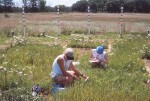A long term study by Cedar Creek LTER researchers has found that plants' capacity to absorb extra carbon from the atmosphere due to elevated carbon dioxide (CO2) levels may be less than expected. A report of the findings entitled "Photosynthetic responses of 13 grassland species across 11 years of free-air CO2 enrichment is modest, consistent and independent of N supply" and authored by Tali D. Lee, Susan H. Barrott, and Peter B. Reich was recently published in the journal Global Change Biology. The report presents data from what is by far the longest running realistic study of elevated CO2 responses of natural vegetation, and with the most plant species.
According to Reich, the data show a smaller stimulation (fertilization) of photosynthesis by elevated CO2 than is generally thought to occur. This finding is important because heightened photosynthesis and production under rising CO2 is thought to help "soak" up CO2 out of the atmosphere to be sequestered in terrestrial ecosystems.
The Cedar Creek results suggest that carbon cycle models that assume long-lived, strong, elevated CO2 simulation of photosynthesis (e.g. 25%) for all of Earth's terrestrial ecosystems should be viewed with a great deal of caution.

 Enlarge this image
Enlarge this image